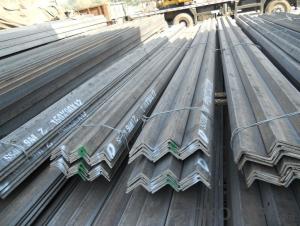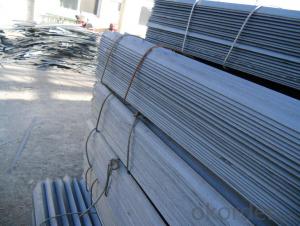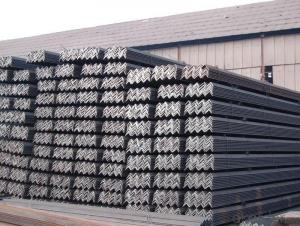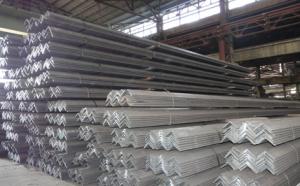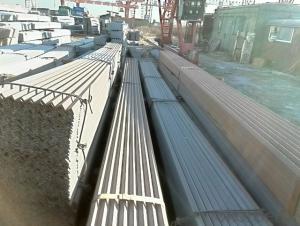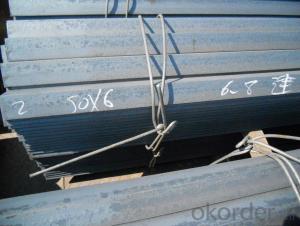Hot Rolled Low Carbon Alloy Angle Steel
- Loading Port:
- China main port
- Payment Terms:
- TT OR LC
- Min Order Qty:
- 100 m.t.
- Supply Capability:
- 20000 m.t./month
OKorder Service Pledge
OKorder Financial Service
You Might Also Like
Product Description:
OKorder is offering Hot Rolled Low Carbon Alloy Angle Steel at great prices with worldwide shipping. Our supplier is a world-class manufacturer of steel, with our products utilized the world over. OKorder annually supplies products to African, South American and Asian markets. We provide quotations within 24 hours of receiving an inquiry and guarantee competitive prices.
Product Applications:
Hot Rolled Low Carbon Alloy Angle Steel are ideal for structural applications and are widely used in the construction of buildings and bridges, and the manufacturing, petrochemical, and transportation industries.
Product Advantages:
OKorder'sHot Rolled Low Carbon Alloy Angle Steel are durable, strong, and wide variety of sizes.
Main Product Features:
· Premium quality
· Prompt delivery & seaworthy packing (30 days after receiving deposit)
· Can be recycled and reused
· Mill test certification
· Professional Service
· Competitive pricing
Product Specifications:
Manufacture: Hot rolled
Grade: Q195 – 235
Certificates: ISO, SGS, BV, CIQ
Length: 6m – 12m, as per customer request
Packaging: Export packing, nude packing, bundled
EQUAL ANGLES SIZES |
| ||
a(mm) | a1(mm) | thickness(mm) | length |
25 | 25 | 2.5---3.0 | 6M/12M |
30 | 30 | 2.5---4.0 | 6M/12M |
38 | 38 | 2.5 | 6M/12M |
38 | 38 | 3.0---5.0 | 6M/12M |
40 | 40 | 3.0---6.0 | 6M/12M |
50 | 50 | 3 | 6M/12M |
50 | 50 | 3.7---6.0 | 6M/9M/12M |
60 | 60 | 5.0---6.0 | 6M/9M/12M |
63 | 63 | 6.0---8.0 | 6M/9M/12M |
65 | 65 | 5.0---8.0 | 6M/9M/12M |
70 | 70 | 6.0---7.0 | 6M/9M/12M |
75 | 75 | 5.0---10.0 | 6M/9M/12M |
80 | 80 | 6.0---10.0 | 6M/9M/12M |
90 | 90 | 6.0---10.0 | 6M/9M/12M |
100 | 100 | 6.0---12.0 | 6M/9M/12M |
120 | 120 | 8.0-12.0 | 6M/9M/12M |
125 | 125 | 8.0---12.0 | 6M/9M/12M |
130 | 130 | 9.0-12.0 | 6M/9M/12M |
140 | 140 | 10.0-16.0 | 6M/9M/12M |
150 | 150 | 10---15 | 6M/9M/12M |
160 | 160 | 10---16 | 6M/9M/12M |
180 | 180 | 12---18 | 6M/9M/12M |
200 | 200 | 14---20 | 6M/9M/12M |
| UNEQUAL ANGLE STEEL | |||||
| size(mm) | a(mm) | a1(mm) | thickness(mm) | kg/m | length(m) |
| 75*50*5 | 75 | 50 | 5 | 4.808 | 6m,9m,12m |
| 75*50*6 | 75 | 50 | 6 | 5.699 | 6m,9m,12m |
| 75*50*8 | 75 | 50 | 8 | 7.431 | 6m,9m,12m |
| 100*75*7 | 100 | 75 | 7 | 9.34 | 6m,9m,12m |
| 100*75*8 | 100 | 75 | 8 | 10.6 | 6m,9m,12m |
| 100*75*9 | 100 | 75 | 9 | 11.8 | 6m,9m,12m |
| 100*75*10 | 100 | 75 | 10 | 13 | 6m,9m,12m |
| 100*75*12 | 100 | 75 | 12 | 15.4 | 6m,9m,12m |
| 125*75*7 | 125 | 75 | 7 | 10.7 | 6m,9m,12m |
| 125*75*8 | 125 | 75 | 8 | 12.2 | 6m,9m,12m |
| 125*75*9 | 125 | 75 | 9 | 13.6 | 6m,9m,12m |
| 125*75*10 | 125 | 75 | 10 | 15 | 6m,9m,12m |
| 125*75*12 | 125 | 75 | 12 | 17.8 | 6m,9m,12m |
| 150*90*8 | 150 | 90 | 8 | 14.7 | 6m,9m,12m |
| 150*90*9 | 150 | 90 | 9 | 16.4 | 6m,9m,12m |
| 150*90*10 | 150 | 90 | 10 | 18.2 | 6m,9m,12m |
| 150*90*12 | 150 | 90 | 12 | 21.6 | 6m,9m,12m |
| 200*100*10 | 200 | 100 | 10 | 23 | 6m,9m,12m |
| 200*100*12 | 200 | 100 | 12 | 27.62 | 6m,9m,12m |
| 200*100*15 | 200 | 100 | 15 | 34.04 | 6m,9m,12m |
FAQ:
Q1: Why buy Materials & Equipment from OKorder.com?
A1: All products offered byOKorder.com are carefully selected from China's most reliable manufacturing enterprises. Through its ISO certifications, OKorder.com adheres to the highest standards and a commitment to supply chain safety and customer satisfaction.
Q2: How soon can we receive the product after purchase?
A2: Within three days of placing an order, we will arrange production. The normal sizes with the normal grade can be produced within one month. The specific shipping date is dependent upon international and government factors, the delivery to international main port about 45-60days.
Q3: what is the difference between actual weight and theoretical weight?
A3: All the section steel has two weights: actual weight and theoretical weight. Actual weight is the weighing out when the product delivered from the mill. Theoretical weight is calculated by pieces. The invoice can be based on each of them as your request.
Images:
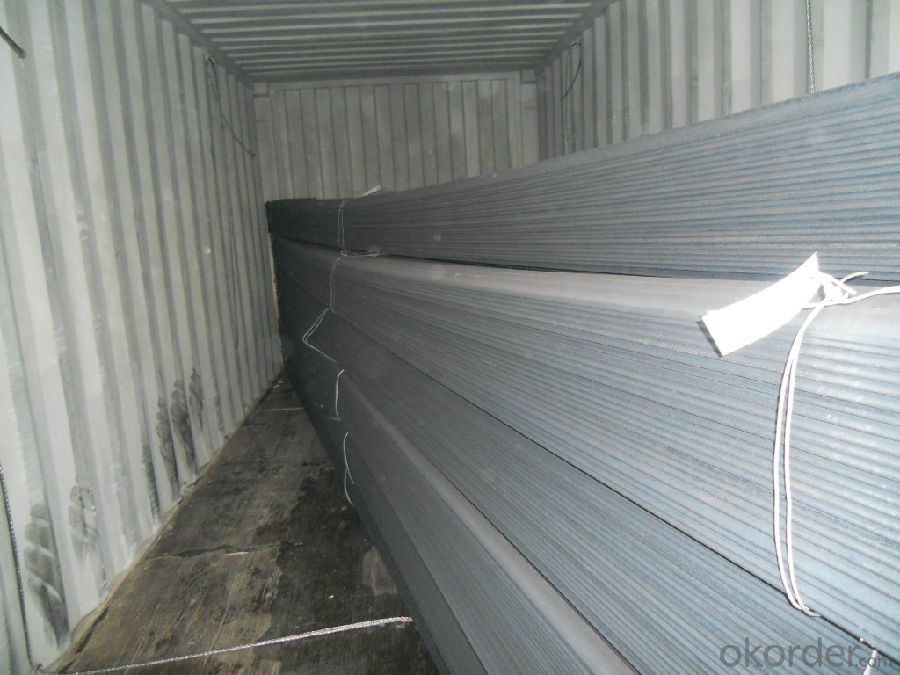

- Q: Can steel angles be used in architectural lighting installations?
- Yes, steel angles can be used in architectural lighting installations. Steel angles provide structural support and can be used to mount lighting fixtures securely. They are often used in applications where durability and strength are important, making them suitable for architectural lighting installations.
- Q: How do you join two steel angles together?
- One common method to join two steel angles together is by using bolts or screws. The angles can be aligned and holes can be drilled through both angles at the desired connection points. Then, bolts or screws can be inserted through the holes and tightened to securely fasten the angles together. Additionally, welding can also be used to join two steel angles together.
- Q: What is hot dip galvanized steel angle?
- It's angle iron. Hot galvanizing is a way of preserving it
- Q: What are the common surface treatments for steel angles to enhance corrosion resistance?
- There are several common surface treatments for steel angles that are used to enhance corrosion resistance. These treatments include: 1. Galvanizing: This is one of the most popular methods used to protect steel angles from corrosion. Galvanizing involves applying a layer of zinc to the surface of the steel through a process called hot-dip galvanizing. The zinc coating acts as a barrier, preventing moisture and corrosive substances from reaching the underlying steel. 2. Paint or Powder Coating: Applying a layer of paint or powder coating to the surface of steel angles can provide an additional layer of protection against corrosion. The paint or powder coating acts as a barrier, preventing exposure to moisture and other corrosive elements. This method is commonly used in applications where aesthetics are important, as it allows for a wide range of color options. 3. Phosphating: Phosphating involves applying a thin layer of zinc or manganese phosphate to the surface of the steel angle. This treatment creates a protective layer that enhances corrosion resistance by providing a barrier between the steel and corrosive substances. 4. Chromate Conversion Coating: This process involves immersing the steel angle in a solution containing chromates, which forms a thin layer of chromate conversion coating on the surface. This coating provides corrosion resistance by acting as a barrier against moisture and other corrosive elements. 5. Mechanical Finishing: Mechanical finishing techniques such as shot blasting or sandblasting can be used to remove any existing rust or scale from the surface of the steel angle. This process helps to improve the adhesion of subsequent coatings and treatments, thereby enhancing corrosion resistance. It is important to note that the choice of surface treatment for steel angles depends on the specific application, environmental conditions, and desired level of corrosion resistance. Consulting with a corrosion specialist or professional in the field can help determine the most suitable treatment for a particular situation.
- Q: What is the typical tolerance for steel angles?
- The typical tolerance for steel angles depends on various factors such as the manufacturing process, standardized specifications, and the intended application. Generally, the typical tolerance for steel angles is within a range of ±1/8 to ±1/4 inch, or ±3 to ±6 millimeters, for dimensions such as length, width, and thickness. However, it is important to consult specific industry standards or the manufacturer's specifications for accurate information on the tolerance of steel angles.
- Q: What is a steel angle?
- An angle iron, also called a steel angle or L-shaped bar, is a type of structural steel product. It consists of two legs that are joined together at a 90-degree angle. This product is widely used in the fields of construction and engineering to provide support and reinforcement to various structures. Its strength and versatility make it a preferred choice in these applications. Steel angles can be made from either carbon steel or stainless steel. They are available in different dimensions, thicknesses, and lengths to cater to different project needs. These angles can be easily cut, welded, and bolted, making them highly convenient for framing, bracing, and supporting beams, columns, and other structural components. In addition to their use in construction and engineering, steel angles are frequently employed in the manufacturing of shelves, brackets, frames, and other metalwork applications.
- Q: What are the different surface treatments for steel angles?
- Steel angles offer a variety of surface treatments to enhance their durability, appearance, and resistance to corrosion. Here are some common treatments: 1. Hot-dip galvanizing: Immersing steel angles in molten zinc forms a protective coating. This treatment is ideal for outdoor use, offering excellent corrosion resistance against moisture and harsh weather conditions. 2. Powder coating: A dry powder paint is applied to the steel angles and then heated to form a durable coating. Powder coating provides various color options and improves resistance to chipping, scratching, and fading. 3. Electroplating: Through an electrochemical process, a metal layer such as zinc, nickel, or chrome is deposited onto the steel angles. Electroplating enhances both aesthetic appeal and corrosion resistance. 4. Priming and painting: Applying primer followed by paint creates a smooth surface and improves adhesion. Painting not only enhances appearance but also provides some protection against corrosion. 5. Anodizing: Typically used for aluminum angles but can also be applied to steel, anodizing creates an oxide layer through an electrolytic process. This treatment improves corrosion resistance, hardness, and color stability. Choosing the appropriate surface treatment for steel angles depends on the specific application and environmental conditions. Each treatment offers unique benefits in terms of corrosion resistance, aesthetics, and durability. Considering these factors ensures the longevity and performance of the steel angles.
- Q: What is the maximum length of a steel angle?
- The maximum length of a steel angle can vary depending on several factors such as the manufacturing process, the available raw materials, and the specific requirements of the project. However, in general, steel angles are typically available in standard lengths ranging from 20 feet to 40 feet. These lengths are commonly used for construction purposes and can be easily transported and installed on-site. It's important to note that customized lengths can also be fabricated based on specific project needs, but they may require additional time and cost. Therefore, it is recommended to consult with a steel supplier or manufacturer to determine the maximum length available for a steel angle based on the desired specifications.
- Q: What are the different shapes available for steel angles?
- There are several different shapes available for steel angles, each serving a specific purpose in various construction and structural applications. The most common shapes of steel angles include: 1. Equal angles: These angles have equal legs and are formed by bending a single piece of steel. They are commonly used for general structural applications, such as supporting beams and columns. 2. Unequal angles: As the name suggests, these angles have unequal legs and are often used when one leg needs to be longer or shorter than the other. These angles are commonly used in construction, where they provide additional strength and support in various applications. 3. L-shaped angles: These angles have one leg longer than the other, forming an L-shape. They are commonly used for reinforcing corners and edges of structures, providing additional strength and support. 4. T-shaped angles: These angles have a longer leg that extends perpendicular to a shorter leg, forming a T-shape. They are commonly used as lintels or beams to support loads above openings like doors and windows. 5. C-shaped angles: These angles have one side curved inward, forming a C-shape. They are commonly used in applications where the angle needs to fit around a curved or rounded surface, providing structural support and reinforcement. Overall, the availability of different shapes for steel angles allows for a wide range of applications in construction and structural engineering, providing strength, support, and versatility in various projects.
- Q: What is the maximum length for a steel angle bracket?
- The maximum length for a steel angle bracket can vary depending on the specific design and manufacturer, but it generally ranges from 6 to 12 inches.
Send your message to us
Hot Rolled Low Carbon Alloy Angle Steel
- Loading Port:
- China main port
- Payment Terms:
- TT OR LC
- Min Order Qty:
- 100 m.t.
- Supply Capability:
- 20000 m.t./month
OKorder Service Pledge
OKorder Financial Service
Similar products
Hot products
Hot Searches
Related keywords
